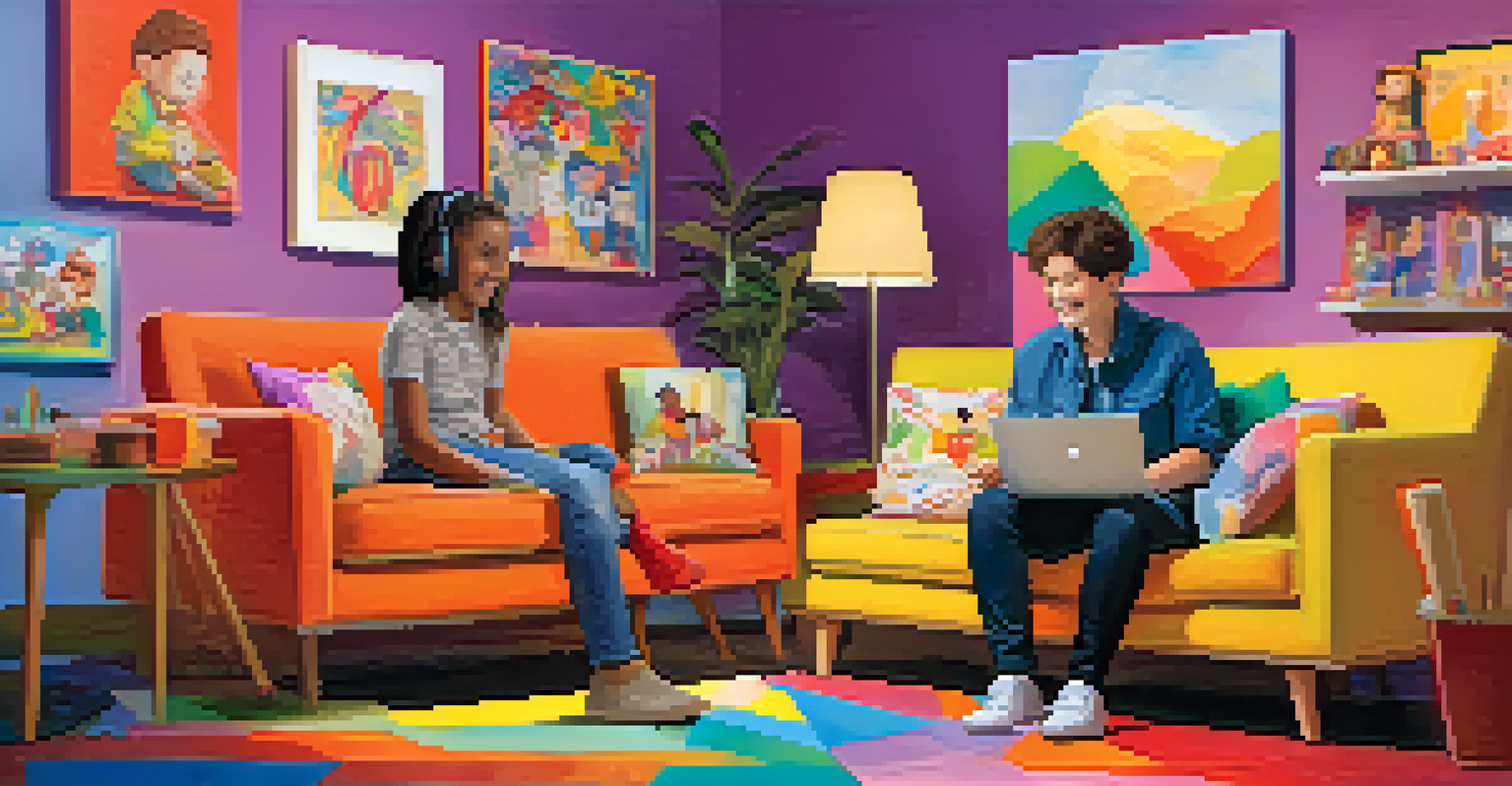Telepsychology for Children: Adapting Techniques for Youth

Understanding Telepsychology: A New Frontier for Kids
Telepsychology is the delivery of psychological services via digital platforms, and it has become increasingly relevant, especially for children. This approach allows therapists to connect with young clients in a comfortable environment, often their own homes. By using video calls or apps, children can communicate their feelings and thoughts without the added pressure of a traditional office setting.
Technology is best when it brings people together.
One major benefit is accessibility; children in remote areas or with mobility challenges can receive the support they need. Telepsychology also opens doors for families who may have scheduling conflicts or transportation issues. This mode of therapy provides a vital connection between children and mental health professionals, making it an invaluable resource during challenging times.
However, it’s important to adapt traditional methods to fit a digital framework. Therapists must be aware of the unique ways children interact with technology and use this to foster engagement. This adaptation can lead to more effective therapy sessions that resonate with younger clients.
Tailoring Techniques: Engaging Children in Teletherapy
Engaging children during teletherapy sessions can be quite different from in-person interactions. Therapists often use playful and creative techniques to capture a child's interest, such as incorporating games or interactive activities. These methods not only make the sessions fun but also encourage children to express themselves more freely.

For instance, using puppets or drawing tools during a video call can help children articulate their feelings in a non-threatening manner. This approach breaks down barriers and allows kids to open up about their thoughts and emotions. Additionally, incorporating storytelling can be a powerful way to convey complex feelings, making the experience relatable.
Telepsychology Enhances Accessibility
Telepsychology allows children, especially those in remote areas or with mobility challenges, to access vital mental health services from the comfort of their own homes.
Creating a comfortable atmosphere is also crucial. Therapists can encourage children to have their favorite toys or comfort items nearby during sessions, helping them feel secure. By fostering a warm environment, therapists can better support children’s mental health needs through telepsychology.
Building Rapport: Establishing Trust in Virtual Settings
Building rapport with children in telepsychology is essential for effective therapy. Since children may feel apprehensive about talking to someone they can't meet face-to-face, therapists must take extra steps to establish trust. A friendly tone, open body language, and showing genuine interest can significantly enhance the therapeutic relationship.
The greatest weapon against stress is our ability to choose one thought over another.
Therapists might start sessions with light-hearted conversations or fun icebreakers to make children feel at ease. This initial connection helps children view therapy as a safe space rather than a daunting task. Consistency in scheduling and maintaining a routine can also contribute to a child's comfort level with their therapist.
Moreover, parents play a pivotal role in this process. Encouraging parents to be involved in the initial sessions can help children feel more secure. When children see their caregivers supporting them, it reinforces the importance of therapy and helps to build a trusting environment.
Incorporating Technology: Tools That Enhance Teletherapy
The right tools and technology can significantly enhance the telepsychology experience for children. Various applications and platforms offer interactive features that make therapy sessions more engaging. For example, virtual whiteboards and drawing apps can allow children to express their feelings visually, providing insights that words alone may not convey.
Additionally, using child-friendly platforms ensures that the technology is easy to navigate. Therapists can recommend apps that help children track their emotions or practice mindfulness, reinforcing lessons learned during sessions. These tools not only aid in communication but also empower children to take an active role in their mental health journey.
Engagement Techniques for Kids
Therapists use playful methods, such as games and storytelling, to engage children during teletherapy, making it easier for them to express their feelings.
However, it's vital for therapists to stay updated on the latest technologies and ensure that they are appropriate for the child's age and developmental stage. By integrating suitable tools, therapists can create a dynamic and enriching teletherapy experience that resonates with young clients.
Challenges of Telepsychology: Navigating Potential Hurdles
While telepsychology offers numerous benefits, it also presents unique challenges, particularly for children. One significant hurdle is the potential for technical difficulties, such as poor internet connection or unfamiliarity with the technology. These interruptions can disrupt the flow of therapy sessions and may frustrate both the therapist and the child.
Another challenge is maintaining focus and engagement during virtual sessions. Children may be easily distracted by their surroundings or the allure of other devices. Therapists need to develop strategies to keep children attentive, such as incorporating movement breaks or interactive exercises that require participation.
Additionally, therapists must be vigilant in monitoring non-verbal cues, which can be harder to interpret through a screen. This means they need to ask direct questions and encourage children to articulate their feelings more explicitly. By proactively addressing these challenges, therapists can create a smoother teletherapy experience for their young clients.
The Role of Parents in Telepsychology: A Collaborative Approach
Parents play a crucial role in the success of telepsychology for children. As primary support figures, they can help set the stage for effective therapy by creating a conducive environment at home. This includes minimizing distractions during sessions and ensuring that the child feels comfortable and secure in their surroundings.
Moreover, parents can assist by reinforcing the strategies discussed during therapy. This collaboration helps to create consistency and allows children to practice skills outside of their sessions. For example, if a therapist suggests breathing exercises, parents can encourage their children to use them during stressful moments.
Parental Involvement is Key
Active participation from parents in telepsychology helps create a supportive environment, reinforcing the strategies discussed during therapy sessions.
It's equally important for parents to maintain open communication with the therapist. Sharing observations about the child's behavior or emotional state can provide valuable context for the therapist. By working together, parents and therapists can create a more holistic approach to the child's mental health.
Future of Telepsychology: Embracing Innovation for Kids
As telepsychology evolves, it holds exciting prospects for children's mental health. The integration of virtual reality (VR) and artificial intelligence (AI) could revolutionize how therapists engage with young clients. For instance, VR can create immersive environments that help children confront their fears in a controlled setting, offering a unique therapeutic experience.
Moreover, continued advancements in technology will likely improve accessibility and effectiveness. As digital platforms become more user-friendly and secure, more children will be able to benefit from telepsychology. This progress presents an opportunity to reach underserved populations and provide mental health support to those who need it most.

Ultimately, the future of telepsychology for children lies in a blend of innovative technology and compassionate care. By remaining adaptable and open to new approaches, therapists can ensure that they are meeting the diverse needs of young clients in a rapidly changing world.